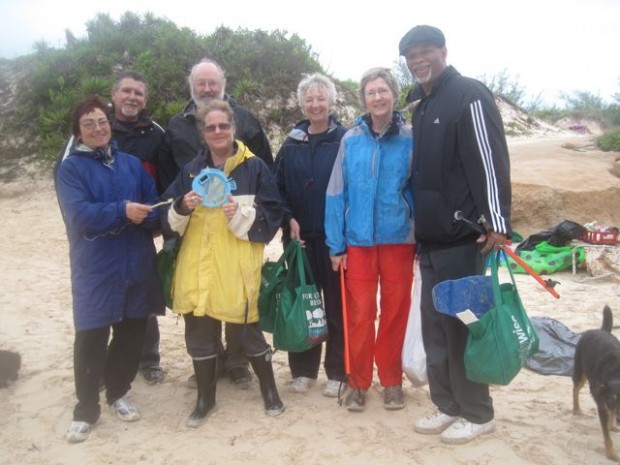Plastic & Trash Collected for Art Show
Despite the wet weather yesterday morning [Feb 12], eight artists from the Arts Centre in Dockyard refused to have their spirits dampened. The artists gathered to clean trash off the Jobson’s Cove, and the trash that they collected will be taken to their studios and sculptures of some sort will be made. There were a total of 15 bags of garbage collected.
A spokesperson said: “From looking in their bags at the end of the morning and speaking with them, we were informed that we might have creations of a dog, the ocean and the earth itself.”
“Although everyone enjoyed the hunt, it was an eye opening experience for all that attended. Vanese Gordon, the Waste Education and Enforcement Officer, arrived with guidance and enthusiasm. The group were shown the bite marks on the plastic that were made from fish thinking that it might be food. It was amazing to see how many pieces had been attacked. And if at a first glance the beach looked clean, all you had to do was turn over a piece of seaweed and there were small pieces of plastic attached.”
“The Arts Centre at Dockyard will be adopting Black Bay in Dockyard. Two of the artists, Mary Tatem and Marlene Jantzen are also school teachers in the west end. It is the hope that all west end schools will become involved with keeping this beach clean. With the help of the Waste Management Section of the Ministry of Works and Engineering, students will be offered an appreciation of why we should not litter, and how bad plastic is for our oceans.”
The artists show – “The Secret Life of Plastic” – will run from March 6-30, at the Bermuda Arts Centre at Dockyard. For more info call 234-2809, for more information on how you can help conserve Black Bay please contact artcentre@ibl.bm.
The information below is taken from the Algalita Marine Research Foundation.
Why is plastic in the ocean a problem?
Because plastic does not biodegrade. When something biodegrades, naturally occurring organisms break down natural materials into their simple chemical components. Paper, when it breaks down, becomes carbon dioxide and water. But plastic, a synthetic material, never biodegrades. Instead, plastic goes through a process called photodegradtation, where it is broken down by sunlight into smaller and smaller pieces. Even this degradation process can take a very long time. Estimates of 500 years for a disposable diaper, 400 years for a plastic six pack ring and 450 years for a plastic bottle have been made. The more plastic we produce, the more we have to live with…. FOREVER!
The ocean is especially susceptible to plastic pollution, because: Plastics are carried by currents, which can concentrate the plastic in certain areas and prevent it from washing onshore. Circulating currents in the ocean caused by stable weather patterns are called “gyres”. When plastic is flushed out of a gyre by storms and washes ashore much of it is mixed into beach sand and can never be recovered.
Many marine birds and animals mistakenly eat free floating plastic: Often these animals cannot distinguish plastic from food. Plastic can never be digested. Eating plastic can cause animals to feel full even though they are not actually consuming food. In birds, it has been shown that ingestion of plastics can prevent migrations and reproduction, and can eventually cause starvation and death. In turtles, plastic has been shown to block intestines and make the animals float so they cannot dive for food.
Over 80 species of seabirds have been found to ingest plastic. Sea bird chicks are especially vulnerable as they receive high levels of pollution from food brought by their parents.
Read More About
Category: All, Environment



